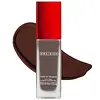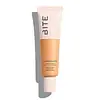One/Size by Patrick Starrr Turn Up The Base Full Beat Liquid Foundation Versus Bite Beauty Changemaker Supercharged Micellar Foundation
What's inside
What's inside
 Key Ingredients
Key Ingredients

No key ingredients
 Benefits
Benefits

 Concerns
Concerns

No concerns
 Ingredients Side-by-side
Ingredients Side-by-side

Water
Skin ConditioningPropanediol
SolventCoco-Caprylate/Caprate
EmollientLauroyl Lysine
Skin ConditioningC13-15 Alkane
SolventTrimethylsiloxysilicate
EmollientPolyglyceryl-3 Polyricinoleate
EmulsifyingC9-12 Alkane
Solvent1,2-Hexanediol
Skin ConditioningDisteardimonium Hectorite
StabilisingSynthetic Fluorphlogopite
Magnesium Sulfate
Aluminum Hydroxide
EmollientHydrogenated Lecithin
EmulsifyingTocopherol
AntioxidantOryza Sativa Hull Powder
AbrasiveCI 77891
Cosmetic ColorantIron Oxides
Water, Propanediol, Coco-Caprylate/Caprate, Lauroyl Lysine, C13-15 Alkane, Trimethylsiloxysilicate, Polyglyceryl-3 Polyricinoleate, C9-12 Alkane, 1,2-Hexanediol, Disteardimonium Hectorite, Synthetic Fluorphlogopite, Magnesium Sulfate, Aluminum Hydroxide, Hydrogenated Lecithin, Tocopherol, Oryza Sativa Hull Powder, CI 77891, Iron Oxides
Water
Skin ConditioningC13-15 Alkane
SolventPropanediol
SolventIsododecane
EmollientPolyglyceryl-6 Polyricinoleate
EmulsifyingMica
Cosmetic ColorantPolymethylsilsesquioxane
Dimethicone
EmollientTrimethylsiloxysilicate
EmollientCaprylic/Capric Triglyceride
MaskingStearoxymethicone/Dimethicone Copolymer
EmollientCoco-Caprylate/Caprate
EmollientPolyglyceryl-10 Dioleate
EmulsifyingDisteardimonium Hectorite
StabilisingHydrogenated Lecithin
EmulsifyingSucrose Polystearate
EmollientSucrose Stearate
EmollientGlyceryl Caprylate
EmollientC24-28 Alkyl Methicone
EmollientPropylene Carbonate
SolventParfum
MaskingGlyceryl Undecylenate
EmollientXanthan Gum
EmulsifyingSodium Hydroxide
BufferingHelianthus Annuus Seed Oil
EmollientMaltose
MaskingAgave Tequilana Leaf Extract
AstringentTriethoxycaprylylsilane
Aristotelia Chilensis Fruit Extract
Skin ConditioningHexyl Cinnamal
PerfumingLinalool
PerfumingLimonene
PerfumingCI 77891
Cosmetic ColorantIron Oxides
Water, C13-15 Alkane, Propanediol, Isododecane, Polyglyceryl-6 Polyricinoleate, Mica, Polymethylsilsesquioxane, Dimethicone, Trimethylsiloxysilicate, Caprylic/Capric Triglyceride, Stearoxymethicone/Dimethicone Copolymer, Coco-Caprylate/Caprate, Polyglyceryl-10 Dioleate, Disteardimonium Hectorite, Hydrogenated Lecithin, Sucrose Polystearate, Sucrose Stearate, Glyceryl Caprylate, C24-28 Alkyl Methicone, Propylene Carbonate, Parfum, Glyceryl Undecylenate, Xanthan Gum, Sodium Hydroxide, Helianthus Annuus Seed Oil, Maltose, Agave Tequilana Leaf Extract, Triethoxycaprylylsilane, Aristotelia Chilensis Fruit Extract, Hexyl Cinnamal, Linalool, Limonene, CI 77891, Iron Oxides
Ingredients Explained
These ingredients are found in both products.
Ingredients higher up in an ingredient list are typically present in a larger amount.
C13-15 Alkane is a group of alkanes with 13 to 15 carbon atoms in the alkyl chain.
It is a solvent and texture enhancer. Solvents are used to keep ingredients together in a product. They can help dissolve ingredients to stable bases or help evenly distribute ingredients throughout the product.
Ci 77891 is a white pigment from Titanium dioxide. It is naturally found in minerals such as rutile and ilmenite.
It's main function is to add a white color to cosmetics. It can also be mixed with other colors to create different shades.
Ci 77891 is commonly found in sunscreens due to its ability to block UV rays.
Learn more about CI 77891Coco-Caprylate/Caprate is created from fatty coconut alcohol, caprylic acid, and capric acid.
It is a lightweight emollient. Emollients create a thin barrier on the skin to trap moisture in. This helps keep your skin hydrated and soft.
Once applied, Coco-Caprylate/Caprate is absorbed quickly and leaves a silky feel.
Coco-Caprylate/Caprate may not be fungal acne safe.
Learn more about Coco-Caprylate/CaprateDisteardimonium Hectorite comes from the clay mineral named hectorite. It is used to add thickness to a product.
It can also help stabilize a product by helping to disperse other ingredients.
Hectorite is a rare, white clay mineral.
Learn more about Disteardimonium HectoriteHydrogenated Lecithin is created from the hydrogenation of lecithin (a group of phospholipids). Hydrogenation is a chemical reaction between hydrogen and another element.
This ingredient is an emollient and emulsifier. As an emollient, it helps soften skin by trapping moisture within. As an emulsifier, it prevents oil and water ingredients from separating.
Propanediol is an all-star ingredient. It softens, hydrates, and smooths the skin.
It’s often used to:
Propanediol is not likely to cause sensitivity and considered safe to use. It is derived from corn or petroleum with a clear color and no scent.
Learn more about PropanediolThis silicone is an emollient. Emollients create a thin film on the skin to prevent moisture from escaping.
It is not soluble in water and helps increase water-resistance in products.
According to a manufacturer, it can blend seamlessly with silicone oils, such as Cyclopentasiloxane.
Learn more about TrimethylsiloxysilicateWater. It's the most common cosmetic ingredient of all. You'll usually see it at the top of ingredient lists, meaning that it makes up the largest part of the product.
So why is it so popular? Water most often acts as a solvent - this means that it helps dissolve other ingredients into the formulation.
You'll also recognize water as that liquid we all need to stay alive. If you see this, drink a glass of water. Stay hydrated!
Learn more about WaterThis ingredient is a combination of red, black, and yellow iron oxide pigments. This combination of colors is usually found in foundation, because it results in a "skin" color.